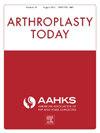手术治疗的抛光锥形滑移股骨柄周围横向或短斜向 B1 假体周围骨折有三分之一的病例需要再次手术:一项回顾性队列研究
IF 2.1
Q3 ORTHOPEDICS
引用次数: 0
摘要
背景全髋关节置换术(THA)骨干周围的横向或短斜股骨假体周围骨折通常被归类为B1骨折(骨干固定良好),通常采用固定治疗。这些骨折的不愈合率很高。本研究旨在确定经手术治疗的骨水泥抛光锥形滑动柄周围横向或短斜向骨折患者的再手术率,并确定与治疗失败的任何关联。方法这项回顾性队列研究纳入了31例Arbeitsgemeinschaft für Osteosynthesefragen横向或短斜Vancouver B1股骨假体周围骨折患者,这些患者均为使用骨水泥锥形滑移骨干的THA患者:12例男性(39%);平均年龄为74±11.9岁(范围44-91岁);平均体重指数为28.5±1.4(范围16-48岁);美国麻醉医师协会评分中位数为3分。对患者的行程进行了评估,并记录了再次干预的情况。结果从初次THA到骨折的平均时间为11.3 ± 7.8年(0.5-26年)。27/31例患者接受了固定手术,4/31例患者接受了翻修型THA(r-THA)手术。10例患者(32%)需要再次手术(8例在ORIF术后,2例在翻修-THA术后,P = .584),最常见的是在受伤后2年内(9/10),原因是不愈合(6/10)。未发现与再次手术要求有明显关联的情况。2 年后免再次手术的 Kaplan-Meier 生存率为 67.4% (95% CI 49.8-85.0),不受最初固定或翻修处理的影响(对数秩 0.898)。在再次手术的患者中,60%(6/10)需要多次再次手术才能达到骨性结合或稳定的翻修结构。应告知患者三分之一的患者有再次手术的风险,五分之一的患者有需要多次再次手术的风险。本文章由计算机程序翻译,如有差异,请以英文原文为准。
Operatively Managed Transverse or Short Oblique B1 Periprosthetic Fractures Around a Polished Taper-Slip Femoral Stem Are Associated With Reoperation in One Third of Cases: A Retrospective Cohort Study
Background
Transverse or short oblique periprosthetic femoral fractures around total hip arthroplasty (THA) stems are typically classified as B1 fractures (stem well-fixed) and usually managed with fixation. These fractures have high non-union rates. This study aimed to identify reoperation rates in patients with operatively managed transverse or short oblique fractures around a cemented polished taper-slip stem and determine any associations with treatment failure.
Methods
This retrospective cohort study included 31 patients with Arbeitsgemeinschaft für Osteosynthesefragen transverse or short oblique Vancouver B1 periprosthetic femoral fractures around THA with a cemented taper slip stem: 12 males (39%); mean age 74 ± 11.9 years (range 44-91); mean BMI 28.5 ± 1.4 (range 16-48); median American Society of Anesthesiologists score 3. Patient journeys were assessed and re-interventions recorded. The primary outcome was reoperation.
Results
The mean time from primary THA to fracture was 11.3 ± 7.8 years (0.5-26 years). Surgical management involved fixation in 27/31 cases and revision-THA (r-THA) in 4/31. Ten patients (32%) required reoperation (8 following ORIF and 2 following r-THA, P = .584), most commonly within 2 years of injury (9/10) due to non-union (6/10). No significant associations with reoperation requirement were identified. Kaplan-Meier survival free from reoperation was 67.4% (95% CI 49.8-85.0) at 2 years, unaffected by initial management with fixation or revision (Log rank 0.898). Of those reoperated, 60% (6/10) required multiple reoperations to achieve bony union or a stable revision construct.
Conclusions
These fractures are challenging to manage with either fixation or revision. Patients should be counseled about a one in 3 risk of reoperation and a one in 5 risk of requiring multiple reoperations.
求助全文
通过发布文献求助,成功后即可免费获取论文全文。
去求助
来源期刊

Arthroplasty Today
Medicine-Surgery
CiteScore
2.90
自引率
0.00%
发文量
258
审稿时长
40 weeks
期刊介绍:
Arthroplasty Today is a companion journal to the Journal of Arthroplasty. The journal Arthroplasty Today brings together the clinical and scientific foundations for joint replacement of the hip and knee in an open-access, online format. Arthroplasty Today solicits manuscripts of the highest quality from all areas of scientific endeavor that relate to joint replacement or the treatment of its complications, including those dealing with patient outcomes, economic and policy issues, prosthetic design, biomechanics, biomaterials, and biologic response to arthroplasty. The journal focuses on case reports. It is the purpose of Arthroplasty Today to present material to practicing orthopaedic surgeons that will keep them abreast of developments in the field, prove useful in the care of patients, and aid in understanding the scientific foundation of this subspecialty area of joint replacement. The international members of the Editorial Board provide a worldwide perspective for the journal''s area of interest. Their participation ensures that each issue of Arthroplasty Today provides the reader with timely, peer-reviewed articles of the highest quality.
 求助内容:
求助内容: 应助结果提醒方式:
应助结果提醒方式:


